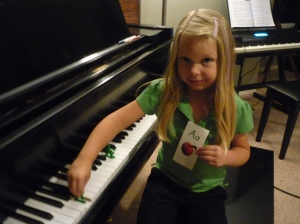Since moving across country this past year, I have been slowly building up my piano studio once again. Usually that means starting with a brand new crop of beginning piano students. And I am no exception! Although I miss having advanced students, I love working with brand-new-“baby” pianists. A few reasons I love the young ‘uns:
1. I love to build my students from the ground up. From the very first lesson, I get to shape and lay the foundation for what will come later. I get the chance to teach exactly what I want them to know. It is very gratifying when we go through subsequent levels of piano methods and I can say “You already know that!”, because I have already laid the foundation.
2. The “light bulb” moments are so awesome. When the young students learn how to do something new, they are so cute because they are so proud of their new accomplishment. I wish we could all unabashedly show our pride at learning something new! It is a good thing!
3. I get to nurture a person’s love of music. I get to guide and direct them into thinking about what makes music good, in all styles of music. What a lovely job description to have.
So…all that to say…I have some brand-new “baby” pianists who need teaching and nurturing. My youngest student is four years old. We are using the Faber My First Piano Adventures series. Recently we have been working on key identification. Realizing we needed some extra work on the concept, combined with the need for fun in the lesson, I began searching the web for game ideas.
I was inspired by this post utilizing a simple key identification game to work on note-naming on the keyboard. It is such a simple game to put together, easy to explain, and fun to play. The trifecta!
This is what you need:
1. Cards with letters A-G printed on them. Put them into a basket. I only had one set of cards, so that’s all I used.
2. Two tokens that are small enough to fit on a single key. I used army men, but you could use anything small – wrapped candy, coins, erasers, etc.
This is what you do:
1. Place both tokens on the low end of the keyboard, not on the keys.
2. The student blindly takes a letter card from the basket.
3. The student moves his token to the first key corresponding to the letter card going up the keyboard. Replace the letter card into the basket.
4. The teacher repeats steps 2 and 3.
5. The game continues until one player reaches the top C on the piano. That player is the winner! (Hopefully it is the student! – it’s usually pretty easy to manipulate the game to make sure the student wins 🙂 )
These are the goals:
1. For the student to be able to identify keys on the keyboard.
2. For the student to understand that as we move higher on the keyboard, we move forward in the alphabet.
3. For the student to understand that the music alphabet is A-G, then start over again on A.
This is a great game! We learned the keys and we had fun. Go try this game with your “baby” pianists!


